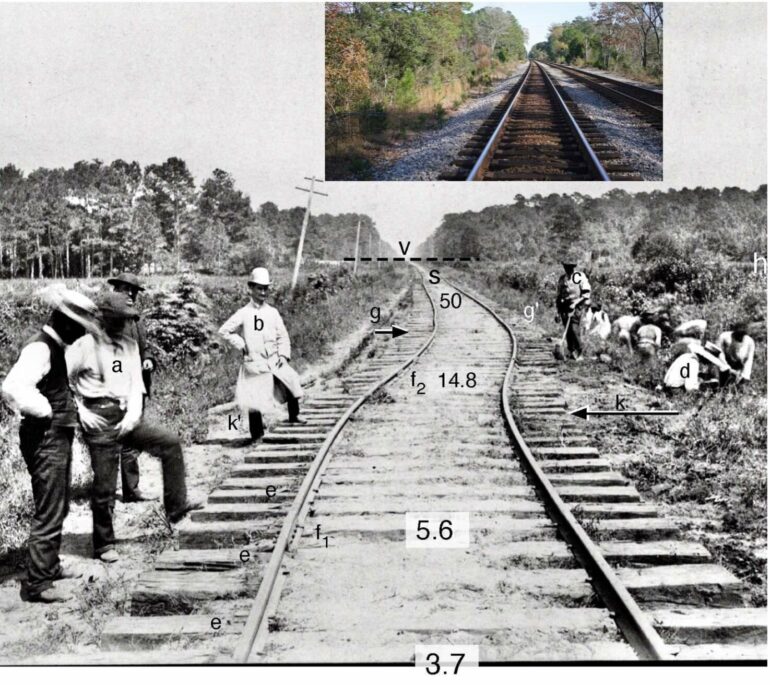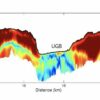Late on August 31, 1886, while many people were asleep, a large quake rocked Charleston, South Carolina, and the surrounding region, toppling buildings, buckling railroad tracks, and causing sand to “boil” or bubble from liquefaction. By the time the shaking stopped, approximately 2,000 structures were damaged and at least 60 people had lost their lives.
The 1886 Charleston earthquake was one of the most powerful earthquakes to strike the eastern United States, with shaking felt as far away as Boston, Chicago, and New Orleans. From 1670 when Europeans first settled in Charleston until that time, the region experienced only occasional minor seismic activity.
As aftershocks rattled the region, geologists and engineers raced into the field, recording detailed notes and taking photographs of the damage. Their observations captured ground disturbances in impressive detail, but scientists didn’t yet fully understand the relationship between earthquakes and faults, so they weren’t able to piece together the complete story.
“The timing of the Charleston Earthquake was unique,” said Susan Hough, a seismologist at the United States Geological Survey (USGS). “If it had happened 75 years earlier, we would have had fewer scientists trained and able to spring into action. If it had happened ten years later, seismograms probably would have recorded the shaking.”
Over a century after the quake, Hough and CIRES Fellow Roger Bilham, a research scientist at CU Boulder, picked up the trail, building on the original records and more recent attempts to piece together the story of the deadly quake.
“Although a dozen possible faults had been identified beneath the swamps surrounding Charleston, the actual fault that ruptured in the earthquake remained a mystery,” Bilham said.
The team’s search through historical documents prompted exciting new discoveries about the Charleston earthquake—from the fault that may be responsible to the magnitude and deformation on the ground.
Their work, published in a series of four papers in 2023 and 2024, provides an example of how scientists can use historical documents to peel back the layers of other geologic mysteries. And in the interior of continental plates, where seismic activity is less frequent, the work may help communities better assess their risk for future earthquakes.
Field evidence reveals faulting
Hough and Bilham started their investigation of the Charleston earthquake by digging deep into the written accounts of the event, including those by Earle Sloan, a mining engineer who took meticulous notes and measurements of the damage to three railroads radiating from Charleston. They suspected that buried within Sloan’s notes were clues that could help them identify the fault responsible for the earthquake.
But there were a few hurdles they had to get over first.
“Converting the numbers into a convincing story turned out to be a nightmare,” Bilham explained. “The 1886 notes inadvertently included entry errors and typos that shifted the positions of buckles indiscriminately hither and thither.”
In 2022, the team traveled to Charleston in hopes of unscrambling the muddle. They zeroed in on a section of the railroad track in Summerville where severe track disturbances had been reported in 1886. Bilham suggested they use GPS methods to establish the locations of observations, which Sloan had tallied using railroad mileposts.
Much to their surprise, the scientists identified a 4.5-meter (14.8-foot) offset to the right in what should be a straight-line mile of track. At first, the scientists couldn’t believe the size of the offset, but upon a closer reading of Sloan’s notes, they discovered that he too had described an offset at the same location. The offset likely meant a fault beneath the tracks had moved. Modern geologists had identified the Summerville fault in that location, but nobody had linked it to the 1886 earthquake.
“It was a moment of serendipity that opened up a whole new dimension to the project,” Hough said.
When they looked at historical maps of the area, Bilham and Hough also found that Summerville appeared to have risen 1 meter (3.3 feet) after the earthquake, whereas the docks at nearby Fort Dorchester had remained undisturbed since their construction in the 17th century. The findings confirmed that something momentous had occurred near Summerville in 1886.
A new model to identify the culprit
To identify the fault responsible for the 1886 Charleston earthquake, the scientists built a mathematical rupture model for movement on the Summerville fault that could explain both the archaeological and geological evidence, including the right offset in the railroad tracks and the uplift in Summerville.
Bilham and Hough found that movement along a west-dipping Summerville fault could explain why the town is situated higher than the surrounding swamps. The model pointed to a 7.3 magnitude, which is consistent with the large “felt” area of the earthquake and previous estimates. They published their results in The Seismic Record in 2023.
“It turns out you can put the pieces together to identify the fault that caused the earthquake and come up with a detailed model for how the fault broke,” Hough said. “It was the first time anyone had done that for the Charleston earthquake.”
After identifying the potential culprit, Hough and Bilham then shifted their attention back to the impacts on the ground. Using the fault location, they simulated what shaking might have been like at different locations and compared the results to observations from the old records. The comparison, which was published in the Bulletin of the Seismological Society of America in January 2024, supports their proposed 7.3 magnitude.
Deformed tracks preserve seismic waves
Bilham continued to dig into the historical documents to sort out why railroad tracks 20 miles from Summerville had been buckled and torn apart.
“It was a monumental undertaking,” Hough said. “It was like Sloan had passed the torch across the ages to Roger.”
An old photograph, taken the day after the Charleston earthquake, showed what appeared to be an offset of railroad track where it crossed a low-lying swamp. Many scientists used the photo to infer faulting in the area.
The scientists constructed a virtual 3D view of the deformed railroad tracking using precise measurements of a thousand points in the original photo, which had survived in the archives of the Charleston Museum. The work led to another stunning realization—the buckled tracks around Charleston had collectively recorded the contraction and compression of seismic waves racing from the epicenter of the earthquake.
“We were able to show that buckles occurred everywhere that the line had been compressed more than permitted by its expansion joints, and that the line had parted where the expansion bolts had broken,” Bilham said.
The work was also published in the Bulletin of the Seismological Society of America.
The bigger picture
Hough and Bilham’s efforts show that even after 137 years, scientists can still learn new things about the Charleston earthquake and contribute to the broader understanding of seismic activity in the region.
“Charleston is a brick in the wall,” Hough said. “Now, we understand one event in one location, but there’s lots of work yet to be done to piece together the larger picture.”
Intraplate earthquakes like the one in Charleston differ from their counterparts, which occur where large pieces of Earth’s crust rub against each other. There is no single pattern to explain why they occur, and often, each event requires a unique investigation. But Hough hopes their work will inspire scientists to look deeper—into the past and the future.
“There is a tendency to assume all knowledge is on the internet and readily available,” Hough said. “Our efforts confirm how much value there can be in considering the dusty original sources of data.”
More information:
Roger Bilham et al, Static and Dynamic Strain in the 1886 Charleston, South Carolina, Earthquake, Bulletin of the Seismological Society of America (2024). DOI: 10.1785/0120240025
Susan E. Hough et al, The 1886 Charleston, South Carolina, Earthquake: Intensities and Ground Motions, Bulletin of the Seismological Society of America (2024). DOI: 10.1785/0120230224
Roger Bilham et al, The 1886 Charleston, South Carolina, Earthquake: Relic Railroad Offset Reveals Rupture, The Seismic Record (2023). DOI: 10.1785/0320230022
Provided by
University of Colorado at Boulder
Citation:
‘Dusty’ archives inspire new story about 1886 Charleston earthquake (2024, May 21)



